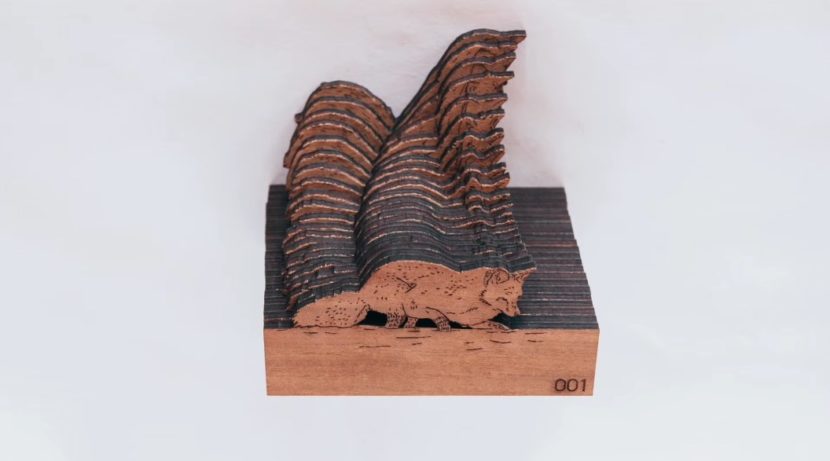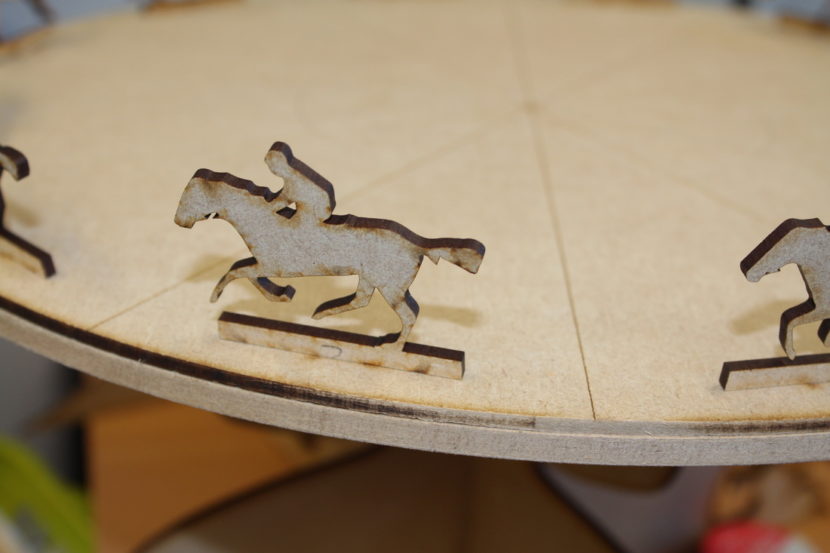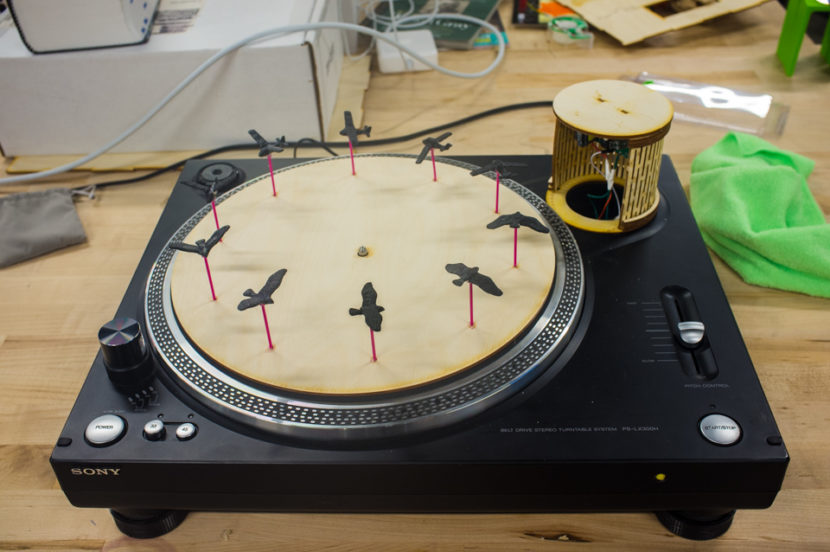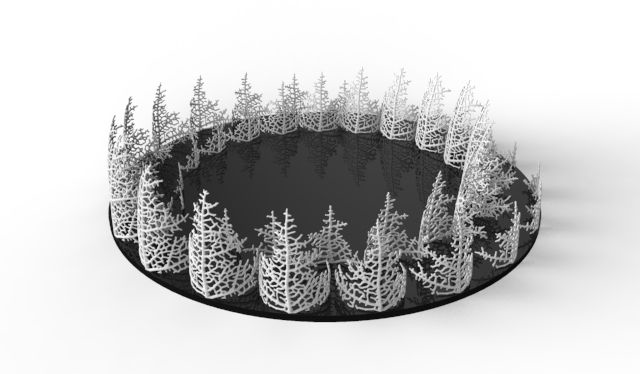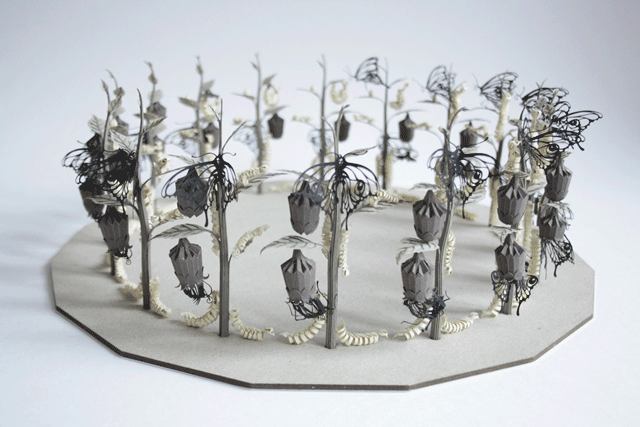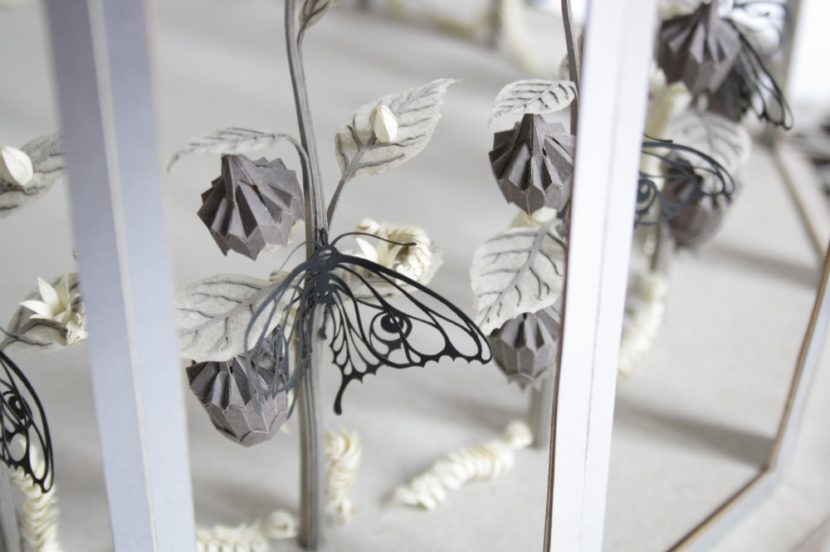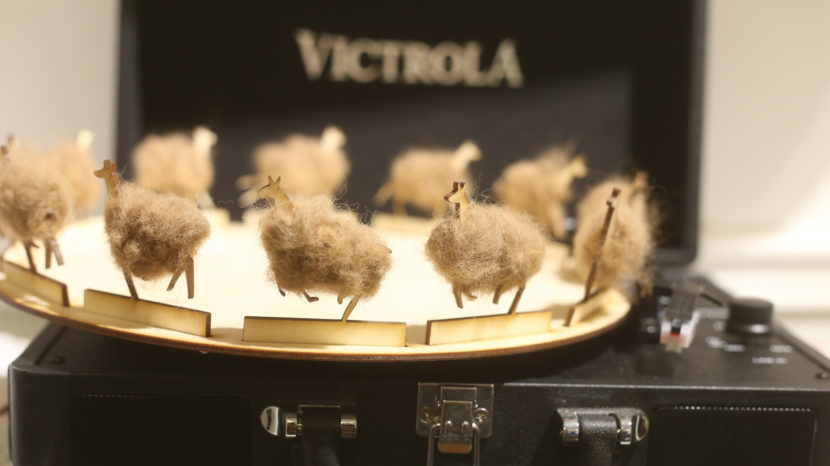
Digital Blueprints in Context | bekky O’Neil | Interdisciplinary Masters in Art Media & Design
The Work
Through this project I set out to create a zoetrope, which is often referred to as a optical toy, or as I prefer, a philosophical toy. From the Greek meaning, literally, “Wheel of Life” the technology is said to have bee pioneered in the 1830s – but human creation of animated rotating devices dated back 5000 years,
Much as I have long been enamoured by the photographic works of Edward Muybridge, and the ways in which science and art merged therein to give us perspective o the world which we inhabit, I am interested in creating animated works that allow us to think about supply chains, and where our resources come from.
In my work towards my MFA thesis I am specifically using animated documentary to explore sustainable agriculture, and have been working to tell stories using materials found or produced on my farm or in my community.
Back in 2015 I started volunteering on a neighbour’s Alpaca farm, and in 2016 had the privilege / chore of being able to help during their annual shearing. Alpaca’s large coats, when sheared are referred to as blankets, and are graded with the lower numbers being the highest quality, and softest. As a fibre artist, Alpaca fluff is lovely but nearly impossible to felt, as I learned the hard way. The fine stuff is very expensive but the more coarse is less in demand, and many bags were given to me to experiment with. In 2016 I first constructed a stop motion puppet with a wire armature with Alpaca hair – but sadly I was not able to animated it as my very large Alaskan Malamute was pleased to find the most delicious toy ever. Literally my dog ate my homework.
So – when the goal of designing an item that merged traditional and digital fabrication techniques was presented, it occurred to me that maybe this would be the change to finally bring an alpaca to life. The name on the bag of roving was “Whirly” so I have named my object for the animal the fibre came from. I like that the performer is in a way made up off the thing that is represents. I like that it is unwashed sand smells like an alpaca. There is something so tactile and fantastic about the smell of the laser cut wood and the felt together, something that can’t really be conveyed in a digital document.
By combining digital animation and real world fabrication my work is hybrid inn another way, and actually hybrid in a way that goes against most of my past work – usually I animated on paper or in photographs with models and turn the animation, as a finished object, into a digital work. Here all the process work is digital but the outcome is analogue – it even sits atop a analogue object – a record player.
I am interested in the hand made and the aspects of digital fabrication that reduce waste, and also create something magical -something that can not be created with traditional fabrication techniques. This is definitely work I hope to continue to explore and develop, but I was glad for the push to be able to put it together.
The Dissemination Plan
My plan to disseminate this work is to finish the zoetrope, make a few others, finesse the plants so that all glitches are worked out and to make a film of the final work (potentially a series of zoetrope – sheep, ducks, cows) which during the credits will direct audiences to my website where they will bee able to find the plans to make their own zoetropes. Conceptual presentation will be first the first goal of presenting this animated work, and will be later followed by opportunity to recreate the performing objects at home.
I like that this method of dissemination presents the work as it is intended – in motion, rather than as just a set of plans, and that it will connect me as creator, and my intentions to the object. To me, this object divorced of intention is just a toy and it has value as a toy, but as a artist I sometimes struggle with open source, and the letting go of my work to have its own life beyond the creator.
I want the maker to think about where our materials come from, and why it matters.
I believe in using 1/8 baltic birch plywood which is lightweight and cost effective that the work would be easy to replicate, or at least emanate. I know not everyone will have access to the material I used. Some may wish to paint their zoetropes, or use commercial wool or sheep’s wool if they are also felters. In that case the laser cut object becomes a canvas which the maker can expand on. Each the same and yet completely unique.
I once listened to a podcast about the houses you could buy in the 20s from a Sears catalogue. Each would be built by hand by the purchase – like an Ikea catalogue for houses… but each would be unique as well, painted or customized to taste. Theirs to personalize. I like the idea of digital objects playing that role.
Ideally users would use my model as a point of departure to modify with their own 12 frame cycles, and create new zoetropes – maybe even ones I could remake and complete the loop.
Critical Analysis
How will the end user interact with the project, using their own tools perhaps located on a different continent?
One of my goals in designing the zoetrope was to be able to create an optical toy that was easy enough to construct that it could be replicated without the necessity of building a complicated rig. The use of a turn table to animate the work was a convenient solution, inspired by image research and the fact that it’s the one turning thing in my studio. Without a strobe in motion it looks like a blur, but it serves as a great rig for photographing it frame by frame.
What considerations must be made to ensure the accurate recreation of your product? Is that even possible?
As I mentioned above, any recreation of the object will be obscured by the change in materials, and so there is no accuracy only reproduction and interpretation – but I hope that makers will think critically about where they source their fibre – and maybe will even consider visiting a farm.
What critical component does digital fabrication address that could not be achieved with traditional fabrication methods?
Working on this scale would be next to impossible with traditional fabrication. I could have done it with paper cuts and exact knives, but ultimately that created fragile work that breaks easily. If I break a piece of the wood it can be glued, or if necessary, that element could be re cut from a new piece of wood.
What complex challenges arise when the designer is no longer in control of the design in question?
The question of ownership and intention are the large ones, and certainly worth considering… but at the end of the day whether we sign something original or duplicate someone else work, I think the goal of art making should be to expand the world. We can never control how our ideas or work will be interpreted, I believe that by putting joyful and positive things out there the possibility to inspire, as other work has inspired me, is too exciting to pass on. Brilliant work hidden at the back of a safe has no utility.
Process & Documentation
Design Challenge / Goals
I set out to create a zoetrope of alpacas made of alpaca wool and laser cut material.
Initial Research & Inspiration
Animation – from reference to line test to silhouette
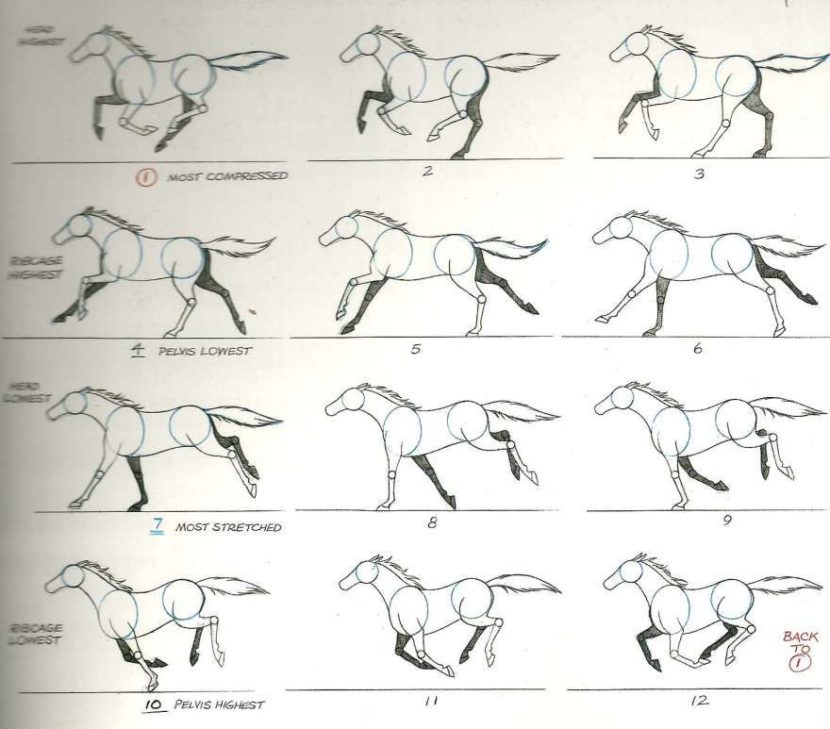
I worked digitally animating in TVPaint animation software with a Wacom Intuos tablet.
The movement was a challenge, as a gallop requires all four legs to leave the ground – which would make the alpaca float and not work at all as a zoetrope. I had to cheat with my drawings to stretch the legs to touch the ground. Once I got the movement right I coloured in my drawings to show only a silhouette.
The I exported the animation as an image sequence, and laid out the frames one by one in a scaled Photoshop document.
Designing the Record – or spatial math
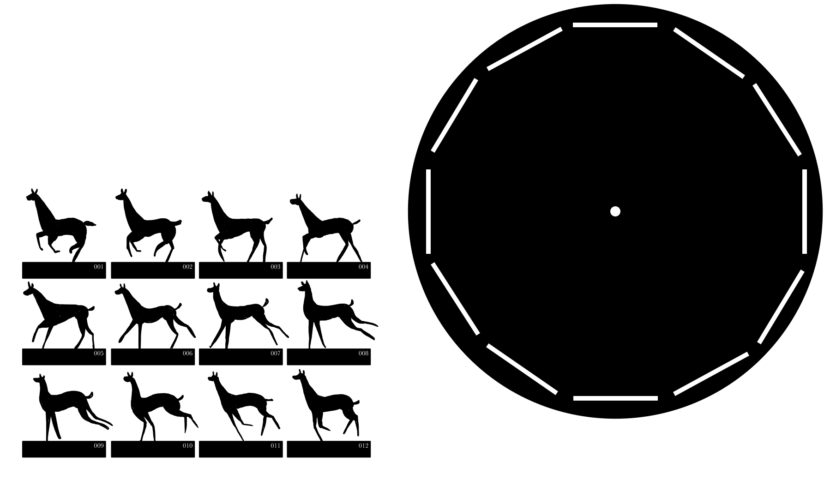
Working at scale in Photoshop I calculated the size of a record, and the record hole, and the necessary spacing for the frames.
Bitmap to Vector
I imported the Photoshop document into Illustrator and used image trace to create a vector image. I then converted the solids to line work for the laser.
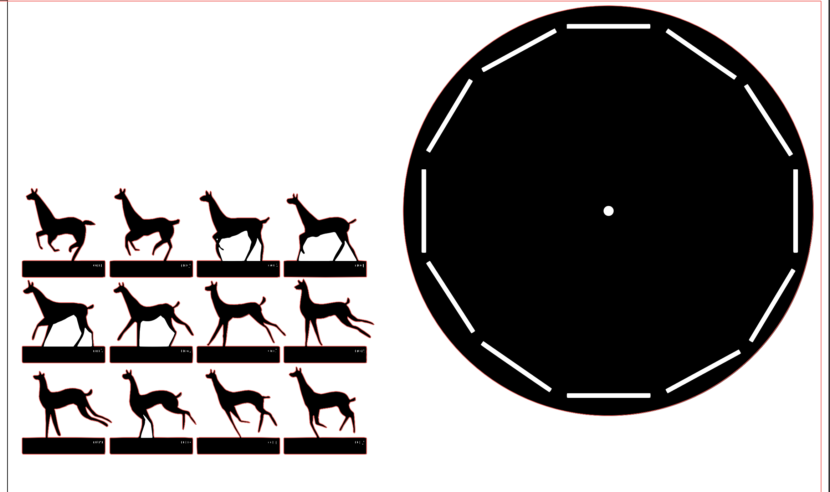
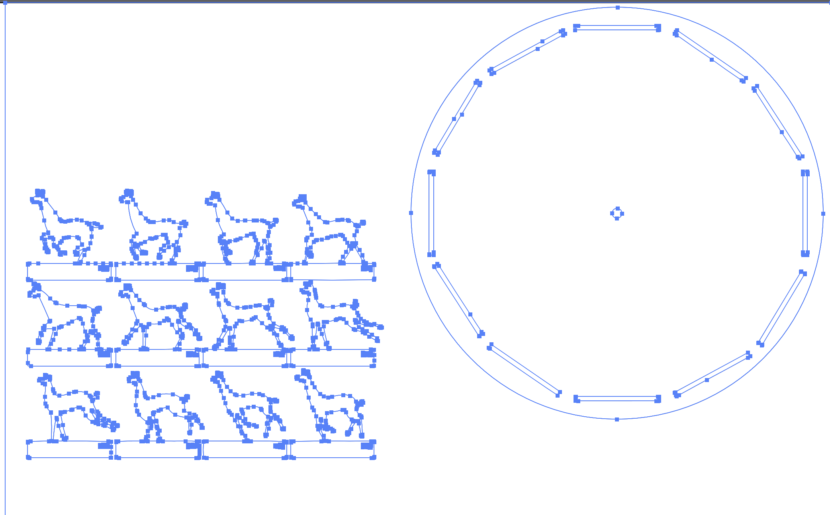
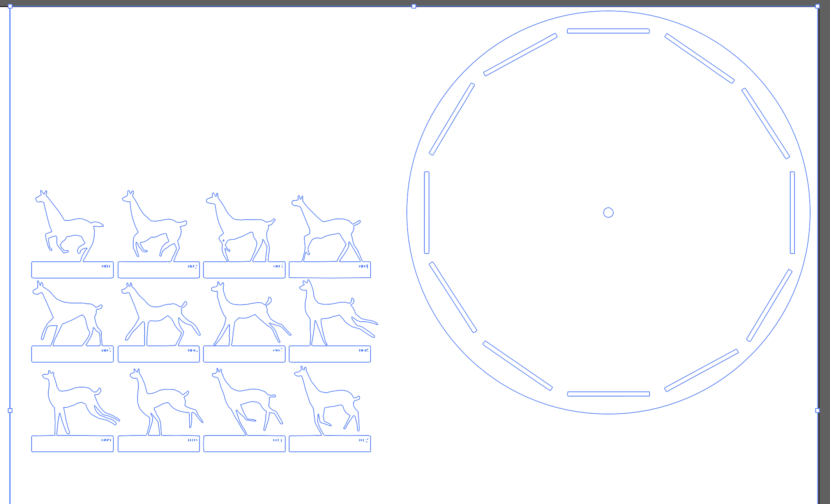
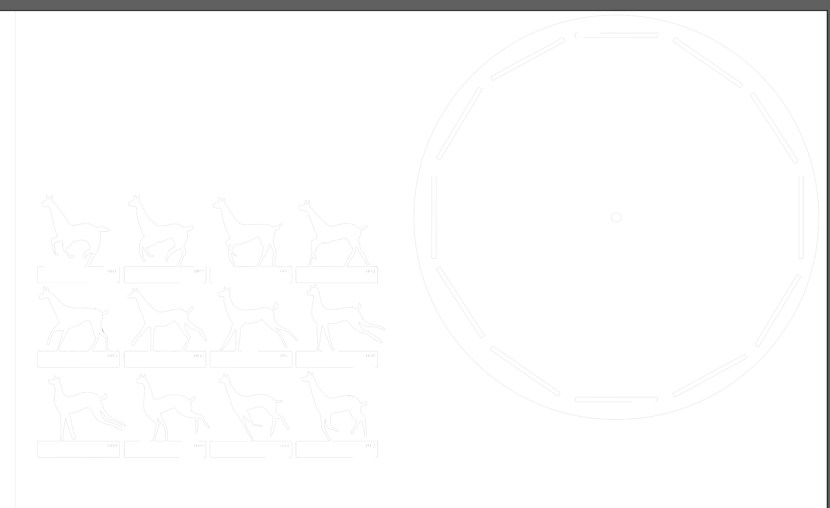
Some detail was lost in this process, and if I had had more time I would have made sure the width of the limbs was more consistent but overall I think it changed for the better.
The Laser Cut / Organizing parts & initial assembly
The pieces came together pretty well once I went through and figured out which position was which. A couple of the frames were cut out incorrectly initially and had to be re done, so the number of each frame varied from one to three… needless to say there were a lot of tiny pieces to sort through. I opted to remove my numbers from the pattern before cutting but ultimately that’s a mistake I won’t make again. There was one piece I couldn’nt find for the life of me, I kept looking through again and again and finally I realized it was still stuck to the piece of baltic birch. Oy.
Needle Felting
So much time, so little progress. I love that the work covered up imperfections in my animated cycle but this material doesn’t want to stick to itself. I broke one of the tiny legs while wrapping wool around it, but managed to white glue it back together.
Preliminary Animation (Zoetrope Tests)
Fortunately the base fit on the turntable with only a minor overlap issue. Taking a couple milliliters off the diameter for the next iteration will help a lot. The record spun well and I have high hopes that with a strobe it will work well. I’m going to try removing half of the frames, or blacking them out to create a digital strobe effect and see if it does anything useful.
Shooting the tests was last minute and done on a time crunch. As such, I didn’t have time to set up a proper tripod or a live feed into Dragonframe Stop Motion Software, so the test is imperfect, but at just twelve frames long it’s surprisingly fun to watch.
Challenges & Next Steps
The next step will be to finesse the felting before I glue the pieces together, making it more stable which will photograph better. I will do the final filming using Dragonframe stop motion, a Canon 6D DSLR Camera and tripod.
I think the next iteration should be oh so slightly smaller – as a piece is hitting part of the turntable back.
I am also interested in programming a 12fps strobe light to make the visual impact without a camera. Maybe I’ll go into the makerspace near me ad see if they want to teach me how to program an arduino 🙂

